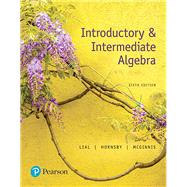For courses in Beginning & Intermediate Algebra.
The perfect combination to master concepts: student-friendly writing, well-crafted exercises, and superb support
The Lial Series has helped thousands of students succeed in developmental mathematics by combining clear, concise writing and examples with carefully crafted exercises to support skill development and conceptual understanding. The reader-friendly style delivers help precisely when needed. This revision continues to support students with enhancements in the text and MyLab™ Math course to encourage conceptual understanding beyond skills and procedures. Student-oriented features throughout the text and MyLab Math, including the Relating Concepts exercises, Guided Solutions, Test Your Word Power, and the Lial Video Library, make the Lial series one of the most well-rounded and student-friendly available.
Also available with MyLab Math
MyLab™ Math is an online homework, tutorial, and assessment program designed to work with this text to engage students and improve results. Within its structured environment, students practice what they learn, test their understanding, and pursue a personalized study plan that helps them absorb course material and understand difficult concepts.
Note: You are purchasing a standalone product; MyLab™ Math does not come packaged with this content. Students, if interested in purchasing this title with MyLab Math, ask your instructor for the correct package ISBN and Course ID. Instructors, contact your Pearson representative for more information.
If you would like to purchase both the physical text and MyLab Math, search for:
0134768531 / 9780134768533 Introductory and Intermediate Algebra Plus MyLab Math -- Title-Specific Access Card Package, 6/e
Package consists of:
- 0134493753 / 9780134493756 Introductory & Intermediate Algebra
- 0134764463 / 9780134764467 MyLab Math with Pearson eText -- Standalone Access Card -- for Introductory & Intermediate Algebra









